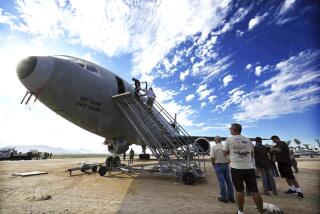More to Sickout Than Meets the Eye
- Share via
Let’s see if we’ve got this straight. The pilots of American Airlines, like that rampaging 50-foot woman of Hollywood B-flick fame, want to destroy their airline by metaphorically flying it into a mountain. Incensed by American’s acquisition of Reno Air, radical union pilots have sunk to Mafia-style tactics, said U.S. District Judge Joe Kendall, as he fined them $10 million for their sick-out.
But do these princes of organized labor really want their airline to go the way of Braniff and Eastern? Are they willing to start over at the bottom of another airline’s seniority list, making a fraction of their reported average $136,000 annual salaries, just because Reno’s pilots won’t get paid that much immediately?
Kendall makes it seem that American’s pilots are egotistical maniacs, bent on rule or ruin, over a relatively trivial issue.
But the historical record tells another story. Since the days of wooden wings, airline pilots have not only been hard-eyed unionists, but solid citizens as well. Most have had military backgrounds, hardly a breeding ground for radical challenges to authority. Furthermore, their careers depend entirely upon the success of their particular airlines, so they are legendary in the labor movement for their “management mentality.”
American’s pilots are admittedly a special case. They stand isolated from the umbrella of organized labor because of a split with the Air Line Pilots Assn., which holds the ‘class and craft” charter from the AFL-CIO. Since their 1963 defection from ALPA, the American pilots’ clone, the Allied Pilots Assn., has functioned as a company union. Only recently has that mattered.
The Airline Deregulation Act of 1978 brought hard times for all airline pilots. After four decades of regulation during which pilots prospered mightily, the industry returned to the kind of free market last seen in the 1920s. A new generation of airline entrepreneurs like Frank Lorenzo, saw airline pilots as ‘underworked and overpaid.” At American, Robert Crandall squeezed his unions less brazenly, but more effectively than Lorenzo. American’s pilots were the first to submit to a “B- scale” salary for new-hire pilots. This generational betrayal rippled outward from American, infecting every pilot group’s pay during the early 1980s. Not until 1985 did the contagion begin to abate, when United’s ALPA pilots fought a 29 day strike over the B-scale.
So American’s pilots suffered not only the condemnation of their professional peers, but further hard times under the icy Bob Crandall, who demanded changed work rules. Fearful of losing their airline to bankruptcy, American’s pilots complied, accepting Crandall’s promises to make them whole once the crisis had passed. He didn’t. So the APA grumpily responded with a common version of pilot’s revenge, variously known as “W.O.E.’(Withdrawal Of Enthusiasm.) Periodic bouts of “crew flu” beset American for nearly two decades.
The APA finally mounted a strike in 1997, but it ended ignominiously when President Clinton stopped it under terms of the Railway Labor Act. Clinton, who had been endorsed by ALPA, had nothing to lose. Thousands of non-pilot AFL-CIO members working for American cheered. American’s pilots fumed.
For the APA, like all pilot groups, job security is far more important than salary. At bottom, that’s what the abortive 1987 strike was about, and that’s what the current Reno Air dispute is about. In 1987, American’s management sought to transfer flying to its subsidiary American Eagle (represented, ironically, by ALPA.) Hard experience has taught airline pilots that management simply cannot be trusted on this issue. Accordingly, they have tried to protect themselves against what pilots call “fragmentation,” and other unions call “out sourcing.” By any name, it involves corporate maneuvers to shift work to people who earn less. From the APA’s perspective, the Reno Air acquisition looks phony. They see it as a “back door B-scale,” and they worry that management might begin a series of such acquisitions, simply to transfer their flying to cheaper pilots.
The APA’s leaders thought they had iron-clad contractual guarantees against fragmentation. When American’s management interpreted the contract otherwise, APA President Rich LaVoy had no choice but to give battle. Job security and the integrity of the APA contract lie at the heart of this dispute--not pay for Reno’s pilots (represented by ALPA, incidentally). If American’s pilots had remained within the embrace of ALPA and the AFL-CIO, public perception of them might be more favorable. The pilots of all “major” airlines are essentially fighting the same battle, and despite their lofty status, they have more in common with blue-collar stiffs at General Motors confronting outsourcing than an angry and inconvenienced public probably realizes.
More to Read
Inside the business of entertainment
The Wide Shot brings you news, analysis and insights on everything from streaming wars to production — and what it all means for the future.
You may occasionally receive promotional content from the Los Angeles Times.










